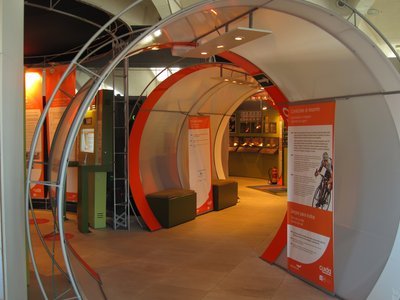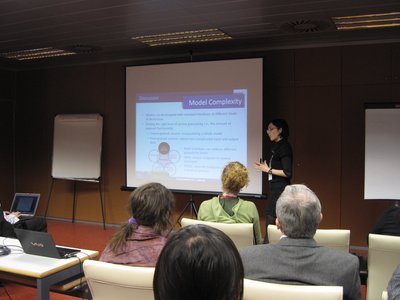SCALABILITY 2024 - The First International Conference on Systems Scalability and Expandability
November 17, 2024 - November 21, 2024
SCALABILITY 2024: Call for Papers
Onsite and Online Options: In order to accommodate various situations, we are offering the option for either physical presence or virtual participation (pdf slides or pre-recorded videos).
The true definition of scalability has to do with meeting demand. Scalable design is a form of responsiveness. Scalability is the ability of a system to provide throughput in proportion to, and limited only by, available hardware resources. A scalable system is one that can handle increasing numbers of requests without adversely affecting response time and throughput.
The growth of computational power within one operating environment is called vertical scaling. Horizontal scaling is leveraging multiple systems to work together in parallel on a common problem. Cloud scalability in cloud computing refers to the ability to increase or decrease IT resources as needed to meet changing demand. Scalability is one of the hallmarks of the cloud and the primary driver of its exploding popularity with businesses. Scaling is one of the most important components of cloud cost management: performance vs. availability vs. scalability tradeoff is essential.
Data storage capacity, processing power and networking can all be scaled using existing cloud computing infrastructure. Better yet, scaling can be done quickly and easily, typically with little to no disruption or down time. Third-party cloud providers have all the infrastructure already in place; in the past, when scaling with on-premises physical infrastructure, the process could take weeks or even months and required tremendous expense.
Whether traffic or workload demands increase suddenly or gradually over time, a scalable cloud solution enables organizations to respond appropriately and cost-effectively to an increased need for storage and performance. The switch to cloud has improved the computing power for organizations that used to run servers on premises. The leading cloud providers - Amazon Web Services (AWS), Microsoft Azure, and Google Cloud Platform - offer flexibility for organizations that may need to add or reduce resources at a moment’s notice.
Virtualization is what makes cloud scalability possible. In cloud computing, scaling is the process of adding or removing computing, storage, and network services to meet the demands a workload has for resources in order to maintain availability and performance as utilization increases.
The number of IoT devices might soon reach 39 billion. Other more complex systems (such as vehicles and power grids, equipped with sensing and storage capabilities) generate huge amounts of data of various types. 5G operation uses a large scale of heterogeneous IoT devices while being performance-efficient in real-time is challenging considering central processing by services hosted on geographically distant clouds (latency incurred and the ingress bandwidth).
To leverage resources located at the edge of the network forming a continuum between the cloud and the edge, the Fog/Edge computing paradigm is expected to increase not only scalability, but also the agile adaptation of sudden traffic, speed, and load changes. The approach deals with latency and bandwidth in close vicinity with data producers (IoT devices, such as home routers, gateways, or more substantial micro data centers) by harnessing the edge. This approach raises security aspects (trust, privacy, guarantees) in edge-based computing.
SCALABILITY 2024 inaugurates a series of events covering all aspects related to scalability challenges and solutions from design, to monitoring, and maintenance of computational systems.
We solicit both academic, research, and industrial contributions. We welcome technical papers presenting research and practical results, position papers addressing the pros and cons of specific proposals, such as those being discussed in the standard fora or in industry consortia, survey papers addressing the key problems and solutions on any of the above topics short papers on work in progress, and panel proposals.
Industrial presentations are not subject to the format and content constraints of regular submissions. We expect short and long presentations that express industrial position and status.
Tutorials on specific related topics and panels on challenging areas are encouraged.
The topics suggested by the conference can be discussed in term of concepts, state of the art, research, standards, implementations, running experiments, applications, and industrial case studies. Authors are invited to submit complete unpublished papers, which are not under review in any other conference or journal in the following, but not limited to, topic areas.
All topics and submission formats are open to both research and industry contributions.
SCALABILITY 2024 conference tracks:
Scalability-driven Data Centers and Cloud computing solutions
Scalability concepts, challenges, and taxonomies
Scalability vs. Availability, Performance, and Resilience
Scalability vs Security in edge resources (Privacy, Trust)
Scalability and High-Performance Computing (HPC)
Opportunistic and cheap computing
Scalability: Data Center vs the Cloud Computation vs Micro Data Centers
Scalability: Clouds vs Edge clouds vs Edge computing vs Fog computing
Scalable architectures for on-site Data centers, in Cloud Data Centers and Cloud computing
Scalability mechanisms (virtualization, containerization, optimal placement of virtual machines)
Patterns-driven scalability (distribution, caching, and asynchronous processing)
Design for scalability (load balancing, preventive monitoring, predictive scalability changes)
Scalability for mobile computing (mobile devices)
Data-driven Scalability design (big data, stream data, etc.)
Scalable Systems/Platforms
Delivery models scalability (On Premise; Co-location; Hosting; Infrastructure-as-a-Service (IaaS); Platform-as-a-Service (PaaS); Software-as-a-Service (SaaS); Business-Process-as-a-Service (BPaaS))
Cost and scalability trade-off (CAPEX, OPEX)
Scalability and elasticity of Cloud Services for BPaaS
Centralized/decentralized Cloud computing versus Edge/Fog computing
Vertical, Horizontal, and Hybrid Scalability
Built-in scalability and self-triggered scalability actions
Intelligent computing and caching at the network edge
Scalable Hardware/Software Solutions
Software agile scalable methodologies
Design Scalable Software (micro-services, containerization, avoid bottlenecks, single point of failure, favor horizontal scaling, scalability architectural patterns, cashing, APIs, tracking scalability metrics. asynchronous processing, etc.)
Scalable programming
Operating Systems supporting scalability
Scalable Hardware: scalable racks, CPU speed, hardware reconfiguration via matrix, on-chip reconfiguration, scalable servers, blade servers, scalable (multiple) WAN connections, API Gateways, etc.)
Hardware Solid State Drives (SSDs)
Scalable predictive pre-cashing mechanisms
Redundancy clusters and server load balancing for failover
Scalable protocols and algorithms
Scalability in Tier Platforms
Storage/Data Bases
Data-driven frameworks in edge/fog computation
Scaling via Database-as-a-Service (DBaaS)
Emerging High Performance Computing (HPC) workloads
Storage optimization in in Deep Learning Frameworks
Data Exchange in HPC Multi-component workflows
Management frameworks for Deep learning
Multi-tiered storage to accelerate I/O, parallel I/O
Scalability of Databases, Storage, and I/O memory access
Scalability and Bottleneck on Databases access (I/O)
Scalable Storages: Databases, NoSQL storages, Service Registries, File systems, etc.
Redundancy clusters and server load balancing for failover
Scaling in NoSQL, schemaless databases
Distributed Edge/Fog Computing Scalability
Edge/Fog/Cloudlets computing- specific scalability aspects
Scalability metrics and monitoring in distributed computing environment
Horizontal and vertical scalability in edge/fog computing
Scalability in mixed systems - centralized cloud and edge/fog computing
Management, orchestration, and resource scheduling for scaling in edge/fog computing
Scalable storage and data management for edge/fog computing
Scalability of edge/fog systems in mission critical applications
VM migration for scaling in fog/edge and mobile computing
SDN control in edge/fog computing- scalability aspects
Intelligent computing and caching at the network edge
Machine learning and Deep learning at the edge
Multi-domain, multi-operator, and end-to-end edge/fog systems
Multi-access edge (MEC) computing scalability
Edge/fog computing scalability in IoT environments
Edge computing and 5G
Scalability monitoring/management
Scaling Strategies (Manual/Scheduled/Automatic)
Tailored monitoring frameworks (e.g., AWS Cloudwatch for AWS -Amazon)
Management of incremental backup
Preventive scaling (adaptive frequency for scaling changes, dynamic, auto-scaling)
SDN control of network topology and connectivity in edge/fog computing- scalability aspects
Orchestration and management - scalability-oriented design
Multi-domain, multi-operator, and end-to-end edge/fog systems
Scalability aspects in sliced systems
Scalability of Machine Learning and Deep Learning for Pattern-based scalability
Management of cold/warm/hot stand-by scalability components insider Data Centers
Datasets for pre-testing scalability via Load tests
Autonomic and cognitive management support for scalability
Scalable solutions for managed cloud-based databases (e.g., AWS Dynamodb, Google Firestore)
Services/Access/Experiments
Client virtualization (desktop, apps)
User requirements for scalability
Interfaces and User-oriented scalability
Personalized, reactive, adaptable interactions
User scalability via "pay as you go" (with resource allocation mechanisms)
Service scalability in different platforms
Access control, QoS/QoE/SLAs, feedback interactions
Massive scalability platforms (Internet-based systems: Google, Amazon, Facebook, Twitter)
Experiences, experiments, lessons learned, open issues (OpenStack Cloud, Azure, etc.)
Where is scalability important (and counting)?
Edge computing scalability in IoT environments
Massive scalability platforms (Internet-based systems: Google, Amazon, Facebook, Twitter)
Scalability in Industry 4.0/5.0
Scalability-oriented design in 5G/6G sliced systems
Scalability for autonomous vehicles and smart health
Scalability on monitoring energy systems
Fluid dynamics - physical simulation coupled with deep learning
Neuroscience/brain models and scalable simulations
Scalable systems (hydrodynamics, nuclear reactions, gravity, thermal conduction, magnetic fields, and radiation)
Deadlines:
Submission | Sep 16, 2024 |
Notification | Oct 10, 2024 |
Registration | Oct 20, 2024 |
Camera ready | Oct 25, 2024 |
Deadlines differ for special tracks. Please consult the conference home page for special tracks Call for Papers (if any).
INSTRUCTION FOR THE AUTHORS
Authors of selected papers will be invited to submit extended versions to one of the IARIA Journals.
Publisher: XPS (Xpert Publishing Services)
Archived: ThinkMindTM Digital Library (free access)
Prints available at Curran Associates, Inc.
How to submit to appropriate indexes.
Only .pdf or .doc files will be accepted for paper submission. All received submissions will be acknowledged via an automated system.
Contribution types
- regular papers [in the proceedings, digital library]
- short papers (work in progress) [in the proceedings, digital library]
- ideas: two pages [in the proceedings, digital library]
- extended abstracts: two pages [in the proceedings, digital library]
- posters: two pages [in the proceedings, digital library]
- posters: slide only [slide-deck posted on www.iaria.org]
- presentations: slide only [slide-deck posted on www.iaria.org]
- demos: two pages [posted on www.iaria.org]
FORMATS
Only .pdf or .doc files will be accepted for paper submission. All received submissions will be acknowledged via an automated system.
Final author manuscripts will be 8.5" x 11", not exceeding 6 pages; max 4 extra pages allowed at additional cost.
Helpful information for paper formatting for MS Word can be found here.
There is a community provided LaTeX template: the CTAN package iaria (with full IARIA formatting rules, including IARIA citation style, but for providing citation style it is tightly bound to pdflatex+biblatex+biber). In addition, there is also iaria-lite (not bound to pdflatex+biblatex+biber, but compatible with any TeX stack; thus, it cannot provide the IARIA citation formattings, but only the titlepage and content-related IARIA formatting rules). Based on the iaria package, there is a minimal working example as Overleaf template. When you are using the LaTeX templates, please still adhere to the additional editorial rules.
Slides-based contributions can use the corporate/university format and style.
Your paper should also comply with the additional editorial rules.
Once you receive the notification of contribution acceptance, you will be provided by the publisher an online author kit with all the steps an author needs to follow to submit the final version. The author kits URL will be included in the letter of acceptance.
We would recommend that you should not use too many extra pages, even if you can afford the extra fees. No more than 2 contributions per event are recommended, as each contribution must be separately registered and paid for. At least one author of each accepted paper must register to ensure that the paper will be included in the conference proceedings and in the digital library, or posted on the www.iaria.org (for slide-based contributions).
CONTRIBUTION TYPE
Regular Papers (up to 6-10 page article -6 pages covered the by regular registration; max 4 extra pages allowed at additional cost- ) (oral presentation)
These contributions could be academic or industrial research, survey, white, implementation-oriented, architecture-oriented, white papers, etc. They will be included in the proceedings, posted in the free-access ThinkMind digital library and sent for indexing. Please submit the contributions following the instructions for the regular submissions using the "Submit a Paper" button and selecting the appropriate contribution type. 12-14 presentation slides are suggested.
Short papers (work in progress) (up to 4 pages long) (oral presentation)
Work-in-progress contributions are welcome. These contributions represent partial achievements of longer-term projects. They could be academic or industrial research, survey, white, implementation-oriented, architecture-oriented, white papers, etc. Please submit the contributions following the instructions for the regular submissions using the "Submit a Paper" button and selecting the contribution type as work in progress. Contributors must follow the conference deadlines, describing early research and novel skeleton ideas in the areas of the conference topics. The work will be published in the conference proceedings, posted in the free-access ThinkMind digital library and sent for indexing. For more details, see the Work in Progress explanation page. 12-14 presentation slides are suggested.
Ideas contributions (2 pages long) (oral presentation)
This category is dedicated to new ideas in their very early stage. Idea contributions are expression of yet to be developed approaches, with pros/cons, not yet consolidated. Ideas contributions are intended for a debate and audience feedback. Please submit the contributions following the instructions for the regular submissions using the "Submit a Paper" button and selecting the contribution type as Idea. Contributors must follow the conference deadlines, describing early research and novel skeleton ideas in the areas of the conference topics. The work will be published in the conference proceedings, posted in the free-access ThinkMind digital library and sent for indexing. For more details, see the Ideas explanation page. 12-14 presentation slides are suggested.
Extended abstracts (2 pages long) (oral presentation)
Extended abstracts summarize a long potential publication with noticeable results. It is intended for sharing yet to be written, or further on intended for a journal publication. Please submit the contributions following the instructions for the regular submissions using the "Submit a Paper" button and selecting the contribution type as Extended abstract. Contributors must follow the conference deadlines, describing early research and novel skeleton ideas in the areas of the conference topics. The work will be published in the conference proceedings, posted in the free-access ThinkMind digital library and sent for indexing. 12-14 presentation slides are suggested.
Posters (paper-based, two pages long) (oral presentation)
Posters are intended for ongoing research projects, concrete realizations, or industrial applications/projects presentations. The poster may be presented during sessions reserved for posters, or mixed with presentation of articles of similar topic. A two-page paper summarizes a presentation intended to be a POSTER. This allows an author to summarize a series of results and expose them via a big number of figures, graphics and tables. Please submit the contributions following the instructions for the regular submissions using the "Submit a Paper" button and selecting the contribution type as Poster Two Pages. Contributors must follow the conference deadlines, describing early research and novel skeleton ideas in the areas of the conference topics. The work will be published in the conference proceedings, posted in the free-access ThinkMind digital library and sent for indexing. 8-10 presentation slides are suggested. Also a big Poster is suitable, used for live discussions with the attendees, in addition to the oral presentation.
Posters (slide-based, only) (oral presentation)
Posters are intended for ongoing research projects, concrete realizations, or industrial applications/projects presentations. The poster may be presented during sessions reserved for posters, or mixed with presentation of articles of similar topic. The slides must have comprehensive comments. This type of contribution only requires a 8-10 slide-deck. Please submit the contributions following the instructions for the regular submissions using the "Submit a Paper" button and selecting the contribution type as Poster (slide-only). The slide-deck will be posted, post-event, on www.iaria.org.
8-10 presentation slides are suggested. Also a big Poster is suitable, used for live discussions with the attendees, additionally to the oral presentation.
Presentations (slide-based, only) (oral presentation)
These contributions represent technical marketing/industrial/business/positioning presentations. This type of contribution only requires a 12-14 slide-deck. Please submit the contributions following the submission instructions by using the "Submit a Paper" button and selecting the contribution type as Presentation (slide-only). The slide-deck will be posted, post-event, on www.iaria.org.
12-14 presentation slides are suggested.
Demos (two pages) [posted on www.iaria.org]
Demos represent special contributions where a tool, an implementation of an application, or a freshly implemented system is presented in its alfa/beta version. It might also be intended for thsoe new application to gather the attendee opinion. A two-page summary for a demo is intended to be. It would be scheduled in special time spots, to ensure a maximum attendance from the participants. Please submit the contributions following the submission instructions by using the "Submit a Paper" button and selecting the contribution type as Demos. The Demos paper will be posted, post-event, on www.iaria.org.
Tutorial proposals
Tutorials provide overviews of current high interest topics. Proposals should be for 2-3 hour long. Proposals must contain the title, the summary of the content, and the biography of the presenter(s). The tutorial slide decks will be posted on the IARIA site.
Please send your proposals to tutorial proposal
Panel proposals
The organizers encourage scientists and industry leaders to organize dedicated panels dealing with controversial and challenging topics and paradigms. Panel moderators are asked to identify their guests and manage that their appropriate talk supports timely reach our deadlines. Moderators must specifically submit an official proposal, indicating their background, panelist names, their affiliation, the topic of the panel, as well as short biographies. The panel slide deck will be posted on the IARIA site.
Please send your proposals to panel proposal


































